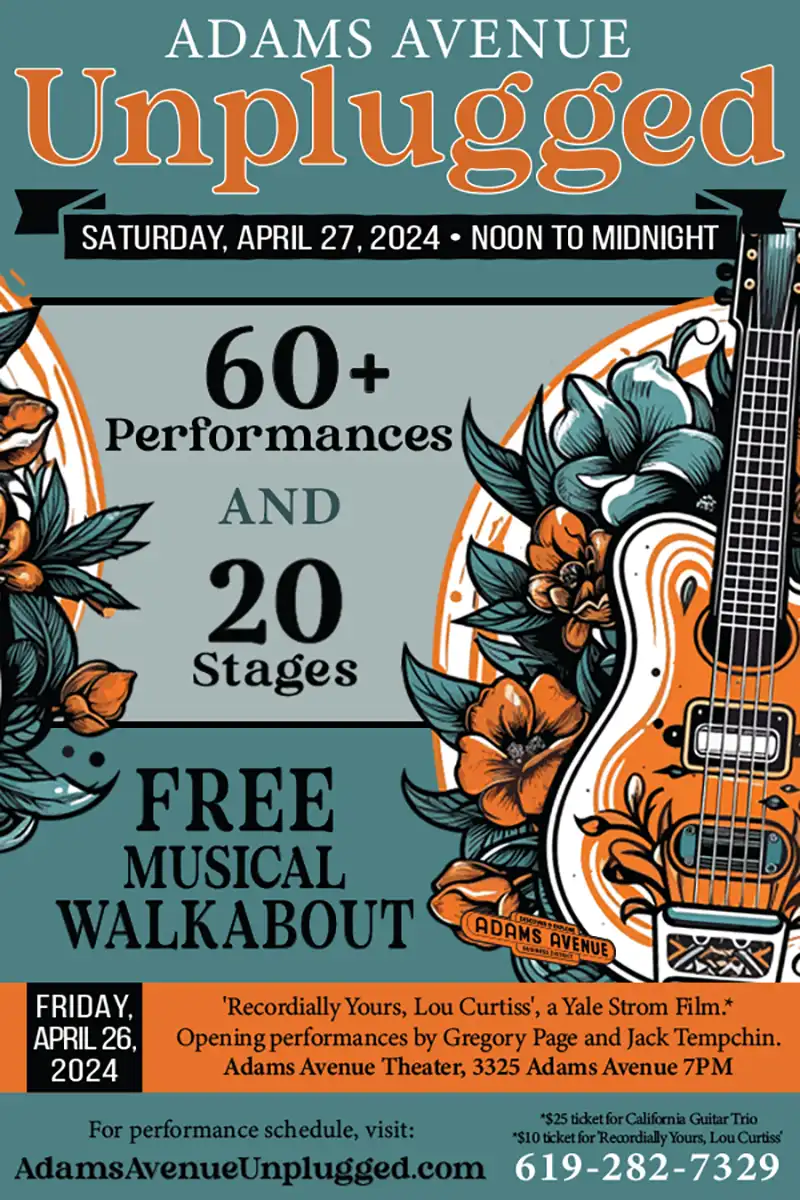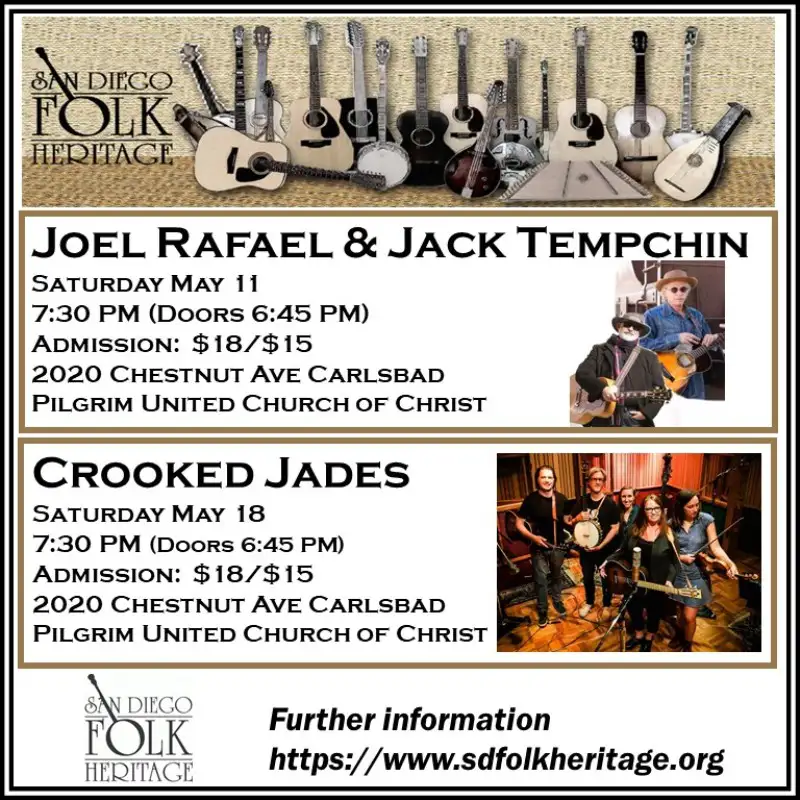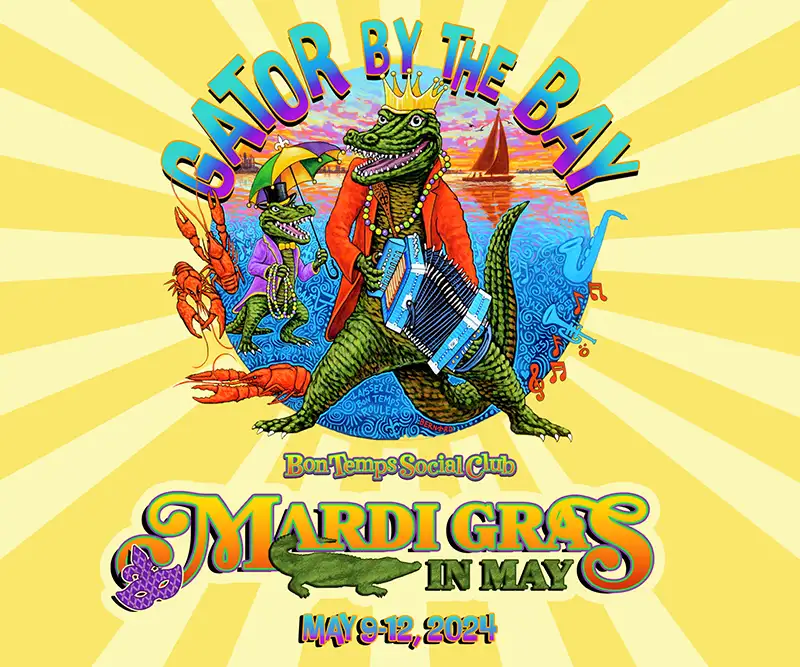Featured Stories
Tolan Shaw: Journey’s End, Journey’s Begin

Tolan Shaw
Tolan Shaw is about to release one of the best local “songwriter” records I’ve heard in a number of years. His self-titled debut is a warm, soulful collection of songs that showcases a deep connection to their style and instrumentation, which many artists spend a lifetime striving toward — an achievement in itself considering Shaw’s mere 24 years of age.
Born and raised in San Diego’s North County and educated at USD, Shaw became a driving force behind the San Diego music award-winning alternative band, the New Archaic, who having gained a lot of local momentum were beginning to gain national attention before its members began pursuing their further education goals.
Having spent time in the Semester at Sea program where he visited China, Japan, India, Brazil, Vietnam, South Africa, Ghana, and Mauritius, Shaw quickly discovered a passion for travel and the inspirational qualities it opened up for him. Following this adventure, he spend over seven months touring South America with his fiancée, teaching English in remote villages and writing the lion’s share of the material for his first solo outing.
Having sat down on a warm spring afternoon overlooking the Pacific in Encinitas to chat about his past travels and trip he’s about to embark upon, it very quickly became clear that as an individual, Tolan Shaw is as tuned into his life and ambition as he is to the musical styles that have inspired him.
San Diego Troubadour: You’re ready to release and in essence about to embark on another set of travels, this time through the life cycle of a record. Where are you hoping it will take you?
Tolan Shaw: Pretty much as far as I can. I’d like to get to a place where I can support myself not only through performing, but through songwriting, licensing ,and publishing. I’m quite new to all of this so I’m learning everyday. I believe that all my contacts both old and new are really going to help shape my next steps and I’m very open to that. I’m currently planning a short Canadian outing alongside friends from the group Sister Speak as well as a short West Coast tour in conjunction with the new record’s release, however I’ve seen a lot of my contemporary local artists disappear on tour, but that doesn’t appear — at least to me — to be a very lucrative way of supporting your art. I’m very much more committed to building my musical roots in San Diego, fostering the hype and resulting connections, then using that local attention to inform and fuel a larger national endeavor. I’m getting married soon so I want to be able to support my family, I’m definitely thinking more long-term than simply running off to have some fun.
SDT: Are there any other musical angles you’d like to explore outside of the inspiration you gain from traveling?
TS: It’s funny because I’ve only written one or two songs in the last year. It’s as though travel is the only way for my creative juices to flow. I really like that cycle: travel, get the song inspiration, write a bunch of songs, come back, record, promote, and repeat. For some reason traveling really affords me [the] time and space that forces reflection. I’m not distracted by my iPhone or computer and I have two or three hours a day where I can just sit and play guitar without having to think about anything except what I’ve been learning, seeing, and experiencing. So many other songwriters get their inspiration from love and heartbreak; I have my own share of love songs, but because I’ve been with the same girl for eight years, I’ve started to become bored of writing anything relationship-based, so a lot of my lyrical ideas come from travel, other cultures, bigger questions and more spiritual experiences. My music is firmly based on what I experience and observe in the world.
SDT: Having interviewed a lot of bands over the years, I’ve learned that many of their songwriters have been in steady relationships for a number of years and when we’ve discussed what I felt were powerful songs about the break down of a romantic relationship were actually about the breakdown of musical ones.
TS: I have a song on the record called “Come Back”; it’s a slower song and it’s about falling in and out of love but it’s not about a relationship whatsoever. It’s about a time during senior year in college where I didn’t know if I wanted to do music. I was being very critical of my music, my voice, and honestly wasn’t sure if this was the direction I wanted my life to take. It’s not about a band break-up but more about documenting my struggle with music as a “lover.”
SDT: Do you have any favorite travel stories, the depth of which won’t necessarily translate through a three to five-minute song?
TS: Twenty-five hour brutal bus rides! [laughs] The deepest parts of the travel that are hard to put into songs are the connections I’ve made and the relationships I’ve contributed to. For example, Sarah and I spent three weeks in a village in Guatemala around Lake Atitlan, teaching English. While we were there we lived with a family who from the outside appeared to live an incredibly monotonous existence with very little in the way of means or possessions, but they smile, they laugh, and face many of the same fundamental and emotional issues as any human being does. That experience really helped me to adjust the judgments I typically make, based upon first impressions of people or a situation. The whole experience of travel has a grounding effect because having been fortunate enough to be born and raised in San Diego and then traveling through some of the less affluent parts of the world, I’ve become incredibly appreciative of the life I’ve had and continue to lead.
SDT: Now that you’re getting married, what are your discussions like as far as your ambitions aligned with your fiancée’s needs and desires?
TS: Sarah is fully on board with my musical ambitions and extremely supportive. We realize it may be a little tricky in the short term as far as having an album release and the initial tour plans coinciding with our wedding arrangements, but honestly I’m going to do everything I can with music for as many years as it takes and I’m determined to be successful. Given that we do have a certain amount of time because we’re young, we’ve decided to put our careers before having children. We’re both ambitious; she’s doing well with her work, so making that a priority for the time being seems like the right thing to do. At the very least we’re staying positive.
SDT: There seem to be so many avenues for artists to promote their craft these days — online and off — where do you see yourself fitting in? How do you fit in as well as being able to stand out?
TS: My whole generation appears to exist mostly online, but I find it very difficult being on a computer, doing that stuff all day. I’d rather be playing music, but engaging with contemporaries and fans alike through the connected medium is something you have to do. I’ll do all the usual stuff — promote through social media, release my record digitally — but I’m most excited to have the physical copies of the album to hand out at shows. In terms of standing out you have to let the music speak for itself. I’m also endeavoring to brand myself in a visual way; I’ve got a gramophone logo and have some actual gramophones wired with lights inside that I’ll be using as stage props. I’m hoping that a visual cue like these will help the audience to remember me and my music. The songs on the album feature a wide range of instrumentation, I’m hoping to put a band together, depending upon the size of the venues we perform, which includes backing singers and a horn section. The album will be tricky to reproduce live with just a four-piece band but I think it will work out. Again, I’m looking at it very positively.
SDT: It really is a great record. I was immediately struck at the depth and soul that came through. It’s very reminiscent to me of the original Muscle Shoals work and then in a similar vein over the last decade to artists such as Cat Power and Ray LaMontagne who have brought that sound back and introduced it to a new generation of listeners. I think your record is inevitably going to draw those comparisons…
TS: That’s kind of what I was hoping for…
SDT: Well, mission accomplished!
TS: I went in and sat with producer Jeff Berkley; it seemed like the right fit and he really knew how to give it that cool, fuzzy, vintage sound. That was really what I wanted: the original Muscle Shoals sound mixed with a newer Ray LaMontagne style. I’m also a big fan of acoustic guitarist and songwriter Michael Kiwanuka and electric guitarist Gary Clark Jr. Some of my more guitar-driven bluesy tunes are inspired by them — as well as Jimi Hendrix, my first and longest influence — but the sound I was mostly looking for derived from ’60s and ’70s soul.
SDT: Tell me about the recording process with Jeff Berkley?
TS: It was amazing. Very collaborative. Before working with Jeff, I wasn’t sure exactly what a producer’s role was. I was under the impression that I did a lot of the producing because I arranged a lot of the pieces, brought other musicians in… but by the end of the process I realized that in his laying back and letting me do my thing when he needed to, he’d interject and say, “No, lets lay off this — it needs a little space here” or “Let’s add this little bit here.” What really came through were those moments when he didn’t touch anything or when he did, it was just perfect. Jeff does everything so organically. He has a real instinct for knowing how and when to be “the producer.” He lays off just the right amount to let the music be itself and breathe so perfectly without trying to control it and strap it into some arbitrary and rigid guidelines. When other musicians came in to contribute, he’d start the process by saying, “These are the parts we were thinking of for this but just do what feels right.” He had a really great analogy that he shared while we were working together: he said that his role is similar to being a jeweler — he doesn’t create the diamond, he creates the setting that allows the diamond to be the best that it can be.
SDT: How did you guys meet and decide to work together?
TS: It was actually thanks to Cathryn Beeks’ San Diego Studio Sampler. She gave a number of songwriters the prompt of “Every Second.” We were to write a song to that, record a rough take in our home studios, and then she had 20 different producers from around San Diego choose the songs they wanted to reproduce in a more professional setting to demonstrate the before and after versions. Jeff chose my song during that process and we really clicked. His style and way of going about the recording worked well with my song and when it came to the material I was thinking of producing next he told me he wanted to do the record.
SDT: Why don’t you give me a run-down on some of the songs?
TS: “Unstoppable” is one of those cheesy-corny pop songs that everyone needs to write once in a while. It’s about my fiancée and those really high moments you have in relationships where everything’s going the right way and every time you’re together it’s just perfect. It was a fun song to write and a fun song to play for her — she loves it. [smiles] One of the more popular songs on the album for sure.
“Waiting” is a song for anyone who is contemplating big life changes. It’s making sure you’re in the right place both in situation and emotion; taking the right steps toward these decisions in the certain knowledge that you’ve done everything you can to prepare yourself so that you’ll be the best you can be for you and everyone else your decisions affect. Essentially it’s about being patient and moving forward when you know the time is right and not rushing into something because you feel pressure and expectation from those around you.
“Meant to Be” and “Awake” — I do a lot of spiritual reading. During our trip I read both The Power of Now and The Spiritual Earth by Eckhart Tolle. That was pretty life-changing, especially while traveling because I had so much time to think about what I was reading. I wrote a lot of songs inspired by this actually; “Awake” came from a part in one of those books that really resonated with me: both of these books are essentially about being in the moment, having a lightness about yourself where you’re able to let things go… not holding onto issues, not being attached to ego, and… it’s about being aware. Respecting yourself and others in the world, living in the moment, and all that stuff. “Meant to Be” is similar to that — letting things be as they will. That’s not to say it’s okay to be apathetic — it’s putting your best foot forward but realizing that whatever happens, happens. You’re putting the results of your decisions and actions into greater hands. I do have a connection with the Christian community and its values, but I feel a greater alignment with its spiritual teachings over any political or institutional agenda. In a tangible sense, what I’m trying to say is that you’re putting the results of your choices in God’s hands. Let whatever it is you’re doing be as it will.
“Satisfaction” was written from the perspective of Satisfaction, as if it were a person. Many people wander around never being satisfied with where they are in life — it’s really easy to do, I’m a culprit of it every single day — you always want to improve and be better, but it’s good to realize that satisfaction and being satisfied is important. It’s the same kind of thing as living in the moment and letting things go. It’s being happy with where you are. The result of this idea is that you’ll achieve more happiness and achieve more of your goals if you are satisfied.
“Why Me?” is a very direct travel story. It came from Panama, I believe… I may have started writing it in Guatemala but I finished it in Panama. It’s a “first world guilt” song. Asking the question, why was I born so healthy in such a wonderful place with such a happy family? The general situation in many third world countries is the same: people live in terrible conditions that they have no control over, yet they’re still wonderful people. Why were they born in a certain place and subjected to a certain circumstance while I was born into a privileged one? The lines in the song are very direct, “Why not the other guy who deserves the same/But was born in a different life in a different place?” It’s one of those big questions that no one can answer but a lot of people think about.
“Mama” is about the universal longing for a mother’s comfort. We’d see it in every single country we’d go to: kids always tugging on their mom’s dress and always wanting their mother’s affection. That carries on through life, always wanting to make mom proud, live how she would want you to live… It applies to fathers or any other parental substitute that you hold in that esteem also. My mom loves that song obviously, it’s her favorite [laughs]
“Change” is about change and it’s difficulties, especially when you’ve known someone for so long and they suddenly change in a way that isn’t in line with your view of them. While our image is not necessarily theirs, we get so upset about the shift when it’s not even really up to us. I’m not saying we shouldn’t feel what we feel… This song was the result of a fiery time in my life when I was upset with people changing and serves as a good reminder that ultimately I shouldn’t take other people’s change personally — that’s not my place.
“Everything’s Not Lost” focuses on another universal theme: hope. The chorus lines are exactly what this song is about — “Every time we fall we get up again/Every time we fail we grow up a bit/Between war there’s a time of peace/Everything’s not lost.” It’s about human resilience. Terrible things happening all the time, but the real test is how we find our way through them.
“Yellow Brick” is a direct reference to the Wizard of Oz. It’s about everyone’s mental image of that ideal place. We all want to walk on yellow brick… But along the same lines as “Satisfaction” sometimes we’ll ultimately get further if we’re satisfied with where we are. When some people aren’t “walking on yellow brick” they put themselves into an unhappy place because they’re not exactly where they want to be. It’s good to have that ideal place in mind — it gives you something to strive for — but don’t forget to try and find some contentment in where you are along the way.
“It’s Alright” is another one that follows the universal sentiment of the record. It’s all about having a lightness; letting things be what they’re meant to be… I’m realizing that most of these inspirations come from a very similar place. I don’t know, is that a good thing?
SDT: I do. I think this really sums up the fact that these are a very cohesive group of songs that represent very solidly and fundamentally where you are at this moment in your life. It’s a good place to start the next stage of the journey: you’re encapsulating one part of your life and hoping it will move you forward into the next stage. That seems to be the overall theme that’s speaking to me through your story.
TS: Yup — you just summed up my thoughts that I couldn’t! [laughs]
Tolan Shaw’s CD pre-release show will be held on June 7 during Carlsbad’s Museum of Making Music “Local Flavor Series” at 7pm. $10 admission includes free slice of pizza and beer. Official CD release at the Belly Up in Solana Beach on June 27th at 9 p.m. Tickets are $15, $17 day of show. A second album release show will be held on Friday, July 12 at Lestat’s in Normal Heights, 8:30pm. Admission is $10. Tolan Shaw’s CD is reviewed this month.
Englishman Tim Mudd manages digital operations for CBS Radio San Diego while his music writing is syndicated throughout the CBS local network nationally. An active member of the San Diego songwriter community for 14 years, he is the President of the San Diego Songwriter’s Guild as well as the guitar player, singer, and songwriter for the Americana group For Strangers & Wardens.







